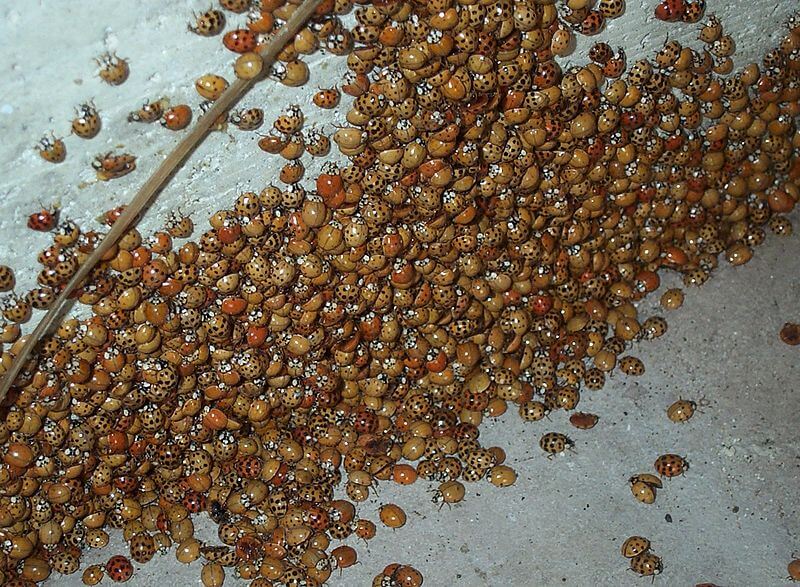Table Of Content

Worldwide, you can find over 4,000 different types of these smelly creatures crawling about. The easiest way to get rid of them is to vacuum them up or sweep them outside. This will likely be a tedious process because you’ll spot another one once you put the vacuum away.

Seal possible entry points
Ladybugs: Why are ladybugs swarming houses this fall and how to get them out? - The Economic Times
Ladybugs: Why are ladybugs swarming houses this fall and how to get them out?.
Posted: Wed, 25 Oct 2023 07:00:00 GMT [source]
Ladybugs are also not known to be attracted to human dwellings. Usually, if you find a ladybug inside your home, it has wandered in by accident. The only exception to this rule is that ladybugs will “overwinter” inside homes during the winter months. Overwintering is a process in which insects will seek out warmer habitats to reside in during the winter.
Spray vinegar around the house to drive ladybugs away

Asian lady beetles will have a white “W” or “M” on their heads. This “W” will vary in size and rough shape but will always be present. Ladybugs, however, have primarily black heads with small white dots or splotches along the sides. Still, it's not entirely effective for getting rid of ladybugs and other pests, especially because it can't break through their hard shell. Vinegar is a strong smell for humans, too, so be careful not to overuse it inside your house. (Or at least pair it with another less pungent smell.) You can use essential oils such as orange peel or tree tea oil with vinegar to create an even more effective repellent.
Find Pest Control Experts Near You
She is a professor of Horticulture, an Education Specialist, and a pest specialist. However, some types of ladybugs are more likely to invade homes than others—so it’s important to get your facts straight before indiscriminately exterminating them. You can find a range of very thorough ladybug repellents and insecticides online. Many of the sprays aim to keep ladybugs from gathering and kill bugs if they do come in contact with the dried spray.
A plant or two may be okay, but the more plants you keep in your home, the more likely you are to have ladybugs trying to find their way inside to them. Ladybugs are extremely small creatures, so it's not hard for them to get around, stay hidden, or fit into tiny spaces. According to This Old House, ladybugs are attracted to warm, cozy, dark spaces, which makes your home the perfect nesting place for them and their eggs.
How To Get Rid of Scale on Plants
A few more easy bee deterrents include peppermint, spearmint, eucalyptus, and thyme. But how exactly do you go about getting rid of bees in an ethical way? Unless you have a friend who is a beekeeper -- in which case, why are you reading this? Before you call your local pest control company, here are some easy, breezy bee-removal methods that you can try at home. USA TODAY is exploring the questions you and others ask every day.
She covers a range of topics, from practical advice to interior and garden design. Her work has been published in various titles including, T3, Top Ten Reviews, Ideal Home, Real Homes, Livingetc. As the Homes Content Editor, Cynthia Lawrence covers all things homes, interior decorating, and garden-related. She has a wealth of editorial experience testing the latest, ‘must-have’ home appliances, writing buying guides and the handy ‘how to’ features.
What causes a ladybug infestation?
This should repel and reduce the number of ladybugs entering your home. Native ladybugs are harmless and incredibly beneficial, given that they consume irritating and harmful garden pests. Native ladybirds shelter outdoors when the weather becomes cold and do not tend to congregate in excessively large numbers.
What Are the Signs You Have a Ladybug Infestation?
The ladybug is red, round, and small, with a calm temperament unless provoked. On the other hand, the Asian ladybeetle is orange, oval, bigger than a ladybug, and can be "aggressive," including biting. If the size and coloring aren't enough to distinguish between the two, look for the white "M" seen behind the Asian ladybeetle's head.
First, Asian beetles are slightly larger than ladybugs, and ladybugs will have a rounder build. While ladybugs are pure, cherry-red, Asian ladybeetles can vary in color, from slightly off-red to yellow or orange. Third, the dot pattern of the wing cover called cerci is far more numerous in ladybeetles than in ladybugs. The most distinguishable characteristic of the two beetles is their head coloration.
During fall, as the weather starts to cool, they seek warm places to hibernate for winter. Homes and other buildings can provide the perfect shelter for these bugs, offering protection from the elements and a source of warmth. Although ladybugs are known for their bright and cheerful appearance, they can become a nuisance when they invade your home or garden. During the cold winter months, these red-and-black spotted bugs may seek warm places to hibernate—including your home’s wall voids and crevices. Then, as the weather warms up, they reemerge and make their presence known.
Mums are known for their colorful fall flowers and pest control super powers. Plant several mums around your home’s exterior, or add bulbs to containers near doors or other points of entry to deter ladybugs. If you’ve spotted ladybugs in your home, you’ll need to know how to get rid of ladybugs fast. While these tiny, red insects are beneficial for our gardens, these can become a nuisance if you have a home invasion.
You’ll also spot these insects hiding in gaps behind baseboards so it’s always important to properly seal and know how to clean baseboards. Alternatively, make a ladybug trap from a bowl of dish soap and water. Ladybugs are generally drawn to the light, so place the bowl next to a window or a bright lamp. The idea is for the ladybugs to land in the water, and get trapped. Start by determining which lady beetle you are dealing with, then formulate a plan of control. If you’re seeing high numbers of ladybugs inside and these techniques aren’t doing the trick, Troyano recommends calling an exterminator for help.
Before engaging in ladybug control, it's critical to identify the species. The common ladybugs, also known as lady beetles or ladybird beetles are known for their role as beneficial insects in gardens. This is because garden ladybugs are predators of many garden insect pests. In fact, the garden is their natural habitat and you won't find ladybugs invading most homes in North America. That said, they differ significantly from invasive species like the Asian lady beetles. Asian lady beetles are more prone to infest home interiors, particularly during colder months.
Introduced in the early 1900s to help control other, more harmful insects, these beetles have become a whole new problem for homeowners. Asian lady beetles congregate indoors, where they find warm, wet areas to lay eggs, and become an infestation. Asian ladybug species often enter homes through small cracks, gaps around door frames, and through broken window screens. Conducting a thorough inspection of your home's exterior and sealing these potential entry points with weather stripping or duct tape is a vital preventative measure.
Recognizing these differences is crucial for effective ladybug infestation management. With vivid wings and familiar black spots, ladybugs are a common sight throughout the warmer summer months. While ladybugs are harmless to humans, they may not be the best roommates. Luckily, there are plenty of ways to avoid and deal with an infestation.

No comments:
Post a Comment